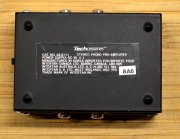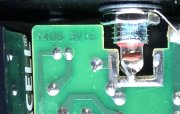Modded board on the left, your board on the right?
Correct!
Left board is currently on offer on eBay, seller's name is 'a1tiptop111'.**
1)
Right board is a NOS (New Old Stock, never used) classic 42-2111 battery powered outboard phono amp (
with RIAA equalization) to allow a standard turntable equipped with a conventional MM (Moving Magnet) cartridge to be connected to the AUX or TAPE input connections on a standard (typically low-cost) preamp that had no phono imputs. (Or did have a phono section, but now it's noisy/buzzy/broken -- for example, vintage Marantz receivers are known to have their phono stages go noisy & require component replacement. (!)
In English, this was a low-cost product that provided the ability to connect a MM cartridge-equipped turntable to a cheap preamp that had no phono input section. Or, it was used as a band-aid/workaround for folks with busted phono stages who didn't want to spend money repairing them. Of course, those who equate $$$ = quality, then obviously these affordable phono preamps couldn't possibly sound good... :0)
****
2) Once Moving Coil cartridges turned out not to be a fad, the high end preamps of the day would usually have
both MM & MC inputs, and this was considered a selling feature. NOTE: The vast majority of consumer gear never added MC phono imputs to their preamps.
3) The third category is a MC phono preamp (outboard) with it's own RIAA equalization network, designed to successfully connect an even lower voltage output MC cartridge to a regular line level preamp input. NOTE: These are almost always targeted at the high end community & priced accordingly.
4) The last category is another kind of a 'band-aid' fix: a MC 'head amp' where a MC cartridge is given just enough boost in order to be connected to a standard (MM) phono input. NOTE: This only supplies gain, with no RIAA equalization onboard. John Curl was a pioneer in this area.
****
If you are relatively new to vinyl and you are confused by all this, it's basically something that evolved over time, and it can be pretty confusing. And for the old guys that grew up with all this, apologies for restating the obvious. :0)
FWIW --
3D
**("2227 auctions, 100% positive feedback" - disclaimer: I've never dealt with this individual at all, just grabbed their auction photo to illustrate the point that these phono preamp boards are routinely modified out in the wild...





